While DeFi continues to evolve, the real trillion-dollar opportunity lies in tokenizing traditional financial assets — bringing stocks, bonds, real estate, and funds on-chain. Ripple, through the XRP Ledger (XRPL), is at the frontier of this shift.
With the rise of institutional interest in real-world asset (RWA) tokenization, Ripple is emerging as a trusted infrastructure provider for bridging legacy finance with the blockchain-powered future.
What Is Tokenization in TradFi?
Tokenization is the process of converting real-world assets into digital tokens that can be stored, traded, or transferred on a blockchain.
This includes:
- 📄 Securities: Stocks, ETFs, bonds
- 🏢 Real estate: Property shares, REITs
- 🪙 Commodities: Gold, silver, oil
- 📊 Funds & structured products
By tokenizing these assets, they become:
- Fractionalized
- Globally accessible
- Programmable
- Tradeable 24/7
- Transparent & auditable
Why Ripple and XRPL for Tokenization?
Ripple offers a unique advantage in bringing TradFi assets on-chain because of its:
🔹 Built-in Token Issuance
The XRP Ledger natively supports asset creation without smart contracts — making it ideal for secure, controlled, and compliant token issuance.
🔹 Speed and Finality
With 3–5 second settlement times and sub-cent transaction fees, XRPL ensures high-volume token transfers are viable.
🔹 Regulatory Mindset
Ripple works closely with regulators and institutions, ensuring tokenized financial products meet compliance standards.
🔹 Interoperability
Ripple’s use of the Interledger Protocol (ILP) and expanding support for EVM-compatible sidechains enhances cross-network token transfers.
Ripple’s Real-World Tokenization Moves
Ripple is not just promoting tokenization — it’s actively building infrastructure and forming partnerships to bring real assets on-chain:
✅ Metaco Acquisition
Ripple acquired Swiss custody firm Metaco to support institutional-grade asset tokenization and digital custody for banks and asset managers.
✅ Tokenized CBDCs and Stablecoins
Ripple’s infrastructure is already being used to tokenize sovereign currencies — a natural extension into other regulated asset classes.
✅ RWA Pilots
Ripple has engaged with fintechs and institutions to tokenize:
- Real estate assets
- Structured finance products
- Digital treasury instruments
These use cases leverage XRPL’s low fees and instant settlement for institutional-grade financial products.
Ripple vs. Ethereum for Tokenized Assets
| Feature | Ripple / XRPL | Ethereum (ERC-20 / ERC-1400) |
|---|---|---|
| Gas Fees | Fraction of a cent | Often $10+ |
| Transaction Speed | 3–5 seconds | 1–6 minutes |
| Built-in Tokenization | Native | Via smart contracts |
| Eco-Friendliness | Very efficient | Moderate (PoS) |
| Enterprise Adoption | High (banks, fintechs) | Growing (via L2s & EVM) |
The Tokenized Future of TradFi
Tokenized TradFi assets will:
- Unlock liquidity from traditionally illiquid markets
- Lower the barrier for global participation
- Enable programmable finance (auto-dividends, compliance, etc.)
- Power new secondary markets with 24/7 trading
Ripple, with its infrastructure and enterprise credibility, is building the bridge that allows regulated financial institutions to confidently tokenize assets without compromising on compliance or performance.
Final Thoughts
Tokenization isn’t a trend — it’s the future of finance.
As institutions shift toward digital assets, Ripple is quietly laying the foundation for tokenizing trillions in traditional financial value.
At Ripplexity, we’ll keep following how Ripple powers this transformation — helping banks, funds, and asset managers step into the on-chain world.










